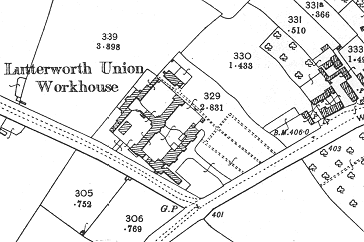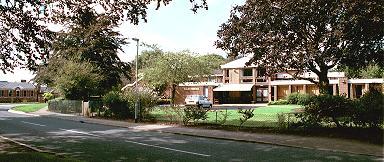Lutterworth, Leicestershire
Up to 1834
Lutterworth had a parish workhouse from 1721. The early workhouse directory An Account of Several Workhouses... reported of Lutterworth that in November, 1724:
THERE are at present but about 20 in it, of which 5 or 6 are Children, whom they are allowed to send to School, to read and write.
THIS Method is like to succeed best, and as our old People wear off, and our young grow up, it will be less chargeable every Year.
THEY live much more comfortably thus in common, than they could have done in their private Houses, with three times the Sum, on Collections, as they call it. Their Pot boils every Day, they have their Cow and Pasture for Milk, their Hog in their Yard, a large Garden to air themselves in, and there be few of our Farmers that live more comfortably than they do.
A parliamentary report of 1777 recorded parish workhouses in operation at Lutterworth for up to 30 inmates, and at Gilmorton for 18.
Lutterworth and a number of other parishes formed a Gilbert Union and established a workhouse on Back Lane, Lutterworth.
After 1834
Lutterworth Poor Law Union officially came into existence on 10th December 1835. Its operation was overseen by an elected Board of Guardians, 36 in number, representing its 35 constituent parishes as listed below:
County of Leicester:
Arnesby, Ashby Magna, Ashby Parva, Bittesby, Bitteswell, Broughton Astley, Bruntingthorpe, Catthorpe, Great Claybrook [Claybrooke Magna], Little Claybrook [Claybrooke Parva], Gilmorton, North Kilworth, South Kilworth, Cotesbach, Dunton Bassett, Frowlesworth [Frolesworth], Kimcote, Knaptoft, Leire, Lutterworth (2), Misterton, Peatling Magna, Peatling Parva, Shawell, Shearsby, Swinford, Ullesthorpe, Walton in Knaptoft, Wigston Parva (until 1895), Willoughby Waterless.
County of Warwick: Copston Magna, Monks Kirby, Pailton, Stretton-under-Foss, Wibtoft, Willey.
Later Additions: Welford (until 1895), Westrill and Starmore (from 1895).
The population falling within the union at the 1831 census had been 13,487 with parishes ranging in size from Catthorpe (population 11) to Lutterworth itself (2,262). The average annual poor-rate expenditure for the period 1833-5 had been £7,548 or 11s.2d. per head of the population.
Lutterworth workhouse was built in 1839-40 on Woodmarket Road in Lutterworth. It was designed by G Gilbert Scott and W Bonython Moffatt who were the architects of many other union workhouses including ones at nearby Loughborough, and at Louth in Lincolnshire. The construction of the Lutterworth workhouse cost £5,000 and it could accommodate 200 inmates. Its layout and location are shown on the 1901 map below.

Lutterworth workhouse site, 1901.
Lutterworth was a typical Scott and Moffatt design with a single-storey block along the front, with a central entrance archway flanked by the porter's lodge and chapel to one side, and the Guardian's board-room and offices to the other. To the rear, the main three-storey accommodation block had the master's quarters at the centre, male inmates to one side, and females to the other. The able-bodied would be house nearest to the master's quarters, with the elderly and children at the outer ends. An infirmary and utility blocks lay at the rear of the site.
After 1930, the workhouse became a Public Assistance Institution. After 1948, it became an old people's home under the name of Woodmarket House. The old workhouse buildings were demolished in around 1970 and replaced with new accommodation for the Woodmarket residential home.

Lutterworth former workhouse site, 2000.
© Peter Higginbotham.
Staff
Inmates
Records
Note: many repositories impose a closure period of up to 100 years for records identifying individuals. Before travelling a long distance, always check that the records you want to consult will be available.
- The Record Office for Leicestershire, Leicester and Rutland, Long Street, Wigston Magna, Leicester, LE18 2AH. Holdings include: Guardians' minutes (1835-1930); Births register (1847-1932); Deaths (1847-1914); Creed registers (1869-1939); etc.
Bibliography
- The Lutterworth Workhouse ed. Roz Bailey, Lynda Hill and Brian Wilkinson (Lutterworth Local History Group, 1998). Price £3 + £1 p&p) from Lynda Hill, at 39, Mulberry Close, Lutterworth, LE17 4DF.
- Lutterworth Workhouse Index: a finding aid for inmates 1808-1900 by Roz Bailey and Lynda Hill. Price £3.50 + £1 p&p from above address.
Links
- None.
Unless otherwise indicated, this page () is copyright Peter Higginbotham. Contents may not be reproduced without permission.


